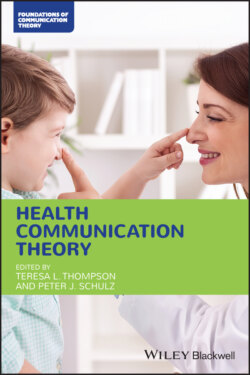Читать книгу Health Communication Theory - Группа авторов - Страница 24
2 Segmenting Priority Audiences Employing Individual Difference Variables to Improve Health Promotion Efforts
ОглавлениеBrian L. Quick, Tobias Reynolds‐Tylus, Salah H. Al‐Ghaithi, and Michael Mackert
Promotional efforts aimed at a priority audience are an important feature of effective health communication efforts (Lee and Kotler 2020). Tailoring and directing messages to a specific audience segment based on demographic, geographic, psychographic, and behavioral variables, as opposed to disseminating promotional messages to the general public, is a much more efficient and effective strategy (McKenzie and Smeltzer 2001). For this reason, during the early stages of a campaign, social marketers and health communication practitioners devote considerable resources to formative research efforts to identify the appropriate psychographics (e.g. barriers, benefits, competition) associated with the specific behavior of interest (Andreasen 1995). Traditionally, social marketers reject the notion of experts designing, implementing, and evaluating promotional efforts without an adequate understanding of the priority audience’s perceptions and self‐efficacy with respect to performing the behavior (Finnell and John 2017).
Audience segmentation has long been considered a necessary practice for the success of communication campaigns (Atkin and Salmon 2013; Donahew 1990; Grunig 1989; Trump 2016). To segment the audience, one divides the population into subpopulations with meaningful shared qualities (Slater 1995), seeking similar audience responses (Atkin and Salmon 2013). This practice is key to designing systematically tailored messages to fulfill the communication needs of the priority audience (Slater 1995), and it provides the basis for selecting channels to reach the intended audience (e.g. radio, word‐of‐mouth, etc; Moriarty et al. 2014). Identifying and understanding the idiosyncrasies of the priority audience enables social marketers and health communication practitioners the opportunity to create messages that resonate with the priority audience’s needs (Andreasen 1995; Lee 2016; Slater 1995). Specifically, tailored messages provide social marketers with benefits such as (i) disseminating messages more effectively to potential adopters, (ii) effectively meeting the needs of potential adopters, (iii) providing greater satisfaction to adopters, and subsequently (iv) increasing the likelihood of sustained adoption (Kotler and Roberto 1989). Slater (1995) suggests meticulous campaign planners rarely overlook careful targeting and audience segmentation strategies, noting that it is important to adapt the style and content of our promotional messages to adequately fit the needs of the priority audience. By carefully tailoring a message to a particular audience segment, Andreasen (1995) suggests campaigners can more effectively meet the priority audience’s needs, thus resulting in desired outcomes. In general, the more health communicators know about their intended audience, the better they can describe them, and as a result, practitioners can tailor messages and utilize appropriate channels with greater specificity and precision (McKenzie and Smeltzer 2001).
Segmentation strategies rely on an educated selection of variables (e.g. demographic, geographic, psychographic, and behavioral) known or assumed to influence attitudes and behaviors (Slater 1996). Among the many available determinants of audience responses, an extensive amount of communication research has identified a handful of individual difference variables to utilize when segmenting audiences. Individual difference variables including involvement (Petty and Cacioppo 1979), health literacy (Aldoory 2017), locus of control (Rotter 1966), reactance proneness (Hong and Faedda 1996), self‐monitoring (Briñol and Petty 2015; Snyder 1979), and sensation seeking (Zuckerman 1979), stand to offer health communication professionals with important psychographics to consider when designing their next social influence initiative. The aforementioned individual difference variables serve as potential audience segmentation variables as extant research demonstrates how each affects individuals’ response to promotional messages (O’Keefe 2013; Shen and Dillard 2009; Shen, Mercer, and Kollar 2015). In this chapter, each of these individual difference variables are discussed with an emphasis on their application as audience segmentation variables for use in future health communication campaigns.
